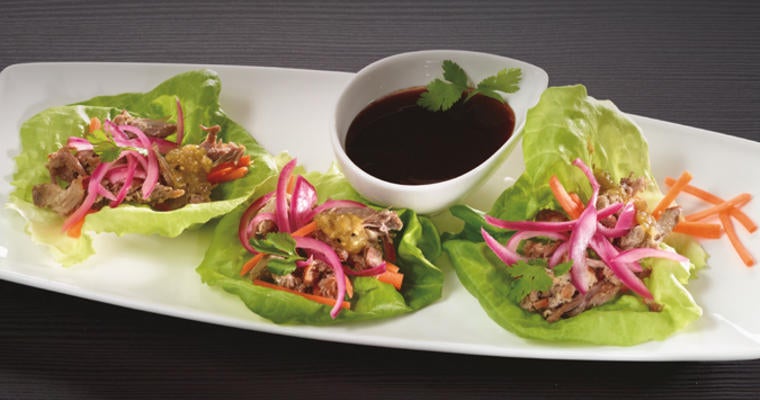With a bit of creativity, virtually any dish is fair game for a duck makeover
A fine-dining superstar has migrated from the silver platter and onto menus of all kinds. Duck appeals both to diners craving distinctive casual fare and to chefs seeking creative and cost-effective ways to satisfy them.
“Duck’s appeal is mostly indulgence for customers, and its popularity and return are probably attributed to the recent high prices of beef,” says Gordon Food Service Corporate Chef Stéphane Renaud. “Chefs are looking more closely at alternatives with better profitability.”
Getting the most duck for the money
A premium protein, duck is pricier than other poultry, but various factors are helping rise in popularity.
“In a time when chicken farmers are having a hard time getting enough chickens to market, duck has an opportunity to make its way onto menus,” says Brad Huizingh, Poultry and Seafood Category Manager for Gordon Food Service Canada.
“Duck breasts have always been the clear preference for chefs,” Renaud says. “Coming second would be the duck-leg confit. This leaves the duck wings and drumsticks.”
Leg and thigh quarters are the most affordable duck option, perfect for braising to achieve great recipe flavours. They’re roughly double the cost of chicken legs, but half the price of duck breast. “Cost-wise, duck legs are a great solution for chefs,” Renaud says.
Huizingh notes, however, that while cost is helping drive demand for legs, producer requirements open opportunities for using the breast meat, as well. “Duck legs are in huge demand,” Huizingh adds, noting that Canadian operators would buy more legs, but farmers often require a commitment to some volume of duck breast.
Duck delivers a rich-tasting escape from the ordinary
Rising demand for poultry dark meat—an outgrowth of consumer cravings for bigger, richer, flavour—is contributing to duck’s popularity. Consumers’ shift away from obsessing about fat—according to Mintel’s trend forecasts for 2016—enhances duck’s appeal.
“People recognize that fat provides richness, satiety, and flavour,” says Gordon Food Service Corporate Consulting Chef Gerry Ludwig, CEC. “Diners gravitate toward duck because they don’t have it that often. They’re looking for a treat—and duck is flat-out delicious. Plus, people don’t want to cook duck at home.”
Distinctive and delectable duck dishes create differentiation and win customers with comforting, craveable fare, whether haute, rustic, global, or regional. Top choices, Renaud says, include: Duck Pot au Feu (braised duck legs served with a French cassoulet); Duck Galantines (duck confit, braised pork belly, and vegetables in gelatin); Duck Risotto; Duck Carpaccio (thin-sliced raw duck breast); Duck Samosas; and Duck Lollipops (whimsically-presented glazed-duck drumsticks).
The right preparation makes duck perfect
Meaty and firm-fleshed, duck-leg quarters require longer, but low- labour preparation. “Duck legs are so lean and have such strong muscles they need to be fully cooked—braised or confit—to be tender,” Renaud advises.
The following approaches can produce excellent results:
Salt curing. Salt-curing concentrates and enhances duck flavour and leaves it moist and tender. Rub duck leg and thigh quarters with salt, cure for a day or two, and then drain on a rack placed over a hotel pan to catch any moisture that leaches out—which should be minimal.
Confit. Rub duck meat with ground spices and slowly braise it immersed in duck fat for incredibly rich flavour.
Oven-roast. This is the preferred method for duck breasts, Renaud notes. Slow-roast seasoned duck legs at a low temperature, then finish at a high temperature to crisp up the skin.
Deep-fry. Finish pre-roasted duck portions briefly in the deep-fryer for a crackly, crunchy, craveable mouthfeel.
Pull. Hand-pull and finely shred roasted or braised duck meat or leave in chunkier portions. Season or sauce for multiple applications.
These methods yield duck meat that’s at the ready for:
- Bar snacks with pulled duck.
- Fillings for tacos, quesadillas, empanadas, pierogi, ravioli, and steamed dumplings or Chinese bao buns.
- Toppings for poutines and entrée salads.
- Sandwiches.
- Entrées showcasing a duck-leg quarter draped luxuriously across a plate or board.
Introduce duck via limited-time offers, appetizers, and sharing plates that swap duck for standard proteins, creating the familiar with a twist. Using duck-leg bones for duck or mixed-poultry bone broths

























